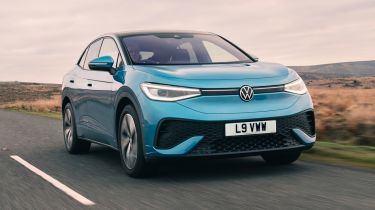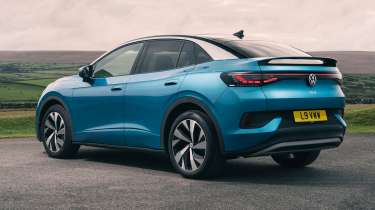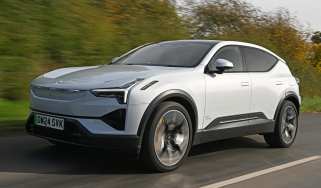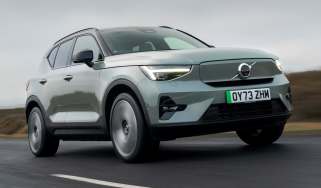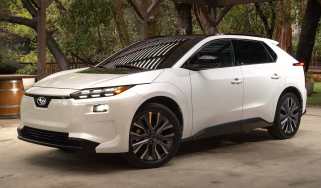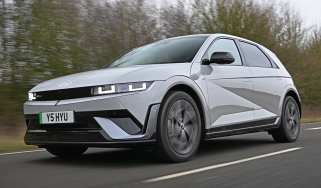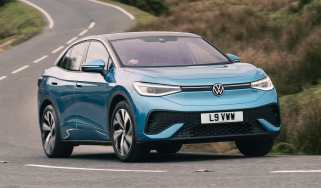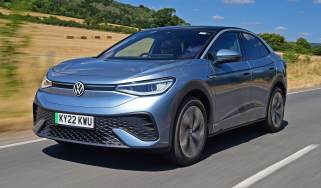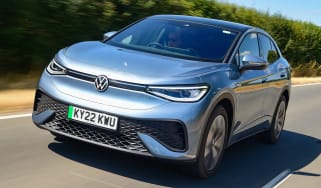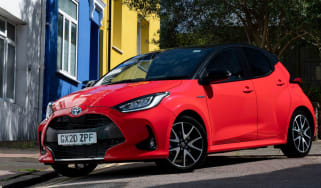Volkswagen ID.5 review – the brand’s electric coupe-SUV
“A coupe version of the ID.4, the Volkswagen ID.5 offers many of the same strengths… and weaknesses”
Pros
- 342-mile range
- Coupe styling, but still practical
- Comfortable even on big wheels
Cons
- Unintuitive touchscreen
- Interior quality isn’t the best
- No cheaper entry-level version
Verdict – is the Volkswagen ID.5 a good car?
The Volkswagen ID.5 is more compelling than when it first launched, having received a power increase across its lineup and simpler trim levels. It’s one of the most comfortable cars in its class and boasts a more impressive range than before, but there’s no denying its lacklustre interior quality, which feels cheap even beside its Skoda Enyaq Coupe sibling. The hot GTX version also somehow fails to feel special – an important factor for such an expensive car
Volkswagen ID.5 models, specs and alternatives
SUVs are now incredibly popular, and these days it’s almost a given that there will be an accompanying coupe-SUV variant – that’s where the ID.5 comes in as a sleeker version of the ID.4 electric SUV.
The good news is that the sloping roofline actually makes the ID.5 marginally more efficient than the ID.4, so you’ll be able to eke out a few miles of extra range when compared with the more upright version. The ID.5 range starts with the Pure, which gets a 52kWh battery providing it with up to 226 miles on a charge, but Pro models get a larger 77kWh one that can keep you going for up to 344 miles.
 Top 10 best electric SUVs – the ones to buy in 2025
Top 10 best electric SUVs – the ones to buy in 2025
Pure versions are also the least powerful models in the range, with Pro ID.5s getting a more potent motor as well as the larger battery. There’s also a top-of-the-range GTX model with the most power and a 79kWh battery – with the focus here on punchier performance, its range figure sits in the middle at 327 miles.
It’s worth noting that Ford’s Explorer and Capri models are based on the same underpinnings as the Volkswagen ID.4 and ID.5, though Ford has tweaked the suspension and steering for a more engaging drive.
An update to the ID.4 and ID.5 electric SUVs came a couple of years into production, swapping out the old infotainment for a larger 12.9-inch screen, and relocating the gear selector from the side of the digital gauge cluster onto a stalk to the right of the steering wheel for a less cluttered look. The benefit to the larger screen is that it feels less like everything is crammed into a small space, and some important features can remain on screen meaning you don’t need to navigate out of apps or poke around so much in order to change things like the climate control, for example. It’s not perfect by any means, but it’s definitely an improvement compared with the previous system.
We still have reservations about the material quality for a car at this price point, which just isn’t as good as those used in the Audi Q4 e-tron Sportback, Tesla Model Y or even the Kia EV6. It’s roughly on a par with the Ford Mustang Mach-E, but we’d even say the Skoda Enyaq Coupe – the ID.5’s cheaper cousin – feels plusher.
Volkswagen heavily simplified the ID.5 lineup since launch, so it’s now offered in just two versions – the standard car is currently only available in Match trim, but the faster GTX is a standalone model in itself.
The Match models get a reversing camera, keyless entry and start, automatic matrix LED headlights, 19-inch alloy wheels, an electrically-operated tailgate and 12.9-inch infotainment screen with sat nav and wireless smartphone charging. There’s lots of safety kit too, so the ID.5 is well equipped. GTX models get a sportier look to reflect the uprated power figure including larger 20-inch wheels. There’s even more sophisticated adaptive suspension to make it better to drive, and high-end additions like a panoramic glass roof, but at just under £10,000 more than the standard car it might not be enough to convince most buyers.
The regular ID.5 might not set pulses racing, but it offers a comfortable ride even on the biggest available wheels. It changes direction sharply at lower speeds, but go into a corner fast and it’ll just push towards the outside of the bend. Sport mode offers heavier steering and a more responsive throttle pedal, but a Ford Mustang Mach-E will still provide greater driving thrills if that’s what you’re after.
With the Pure powertrain option, the ID.5 gets 168bhp, while specifying the Pro increases this to 282bhp – originally the standard car also got a 201bhp power option, but this is no longer the case. The GTX now produces 335bhp, which is 40bhp more than the original GTX – we’re glad this is the case because the original hot version felt a bit lacklustre and failed to feel special.
It’d be reasonable to expect a much smaller boot in the ID.5, because of its roof chop. The good news here is that the drop in practicality isn’t very big, partly because of the way the bodywork rises up towards the rear end. With the rear seats in place, Volkswagen actually quotes a slightly higher boot capacity than for the ID.4, although the total capacity with the seats down is bigger in the ID.4. Even tall adults will be happy enough in the back seats of the ID.5, so it’s still a really usable family SUV.
Which Is Best?
Cheapest
- Name210kW Essential Pro 77kWh 5dr Auto
- Gearbox typeAuto
- RRP£36,985
Most Economical
- Name250kW 4MOTION GTX Edition 79kWh 5dr Auto
- Gearbox typeAuto
- RRP£54,325
Fastest
- Name250kW 4MOTION GTX Edition 79kWh 5dr Auto
- Gearbox typeAuto
- RRP£54,325

